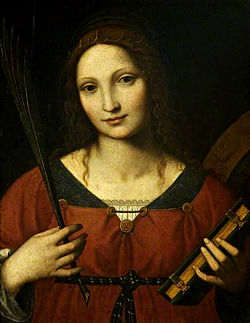My friend Catherine Addington (who followed me as an editorial assistant at AmCon and wrote this nice piece on using Native American authors in English class there) has committed to blogging every day in November, and this essay on her difficult relationship with her name-saint is particularly excellent. I’m excerpting a piece of it here, to persuade you to pop over and read the whole thing.
The priest took my question [about why the parish banned female altar servers] seriously and answered it, I’m sure, but he told my mother when she came to pick me up that day: You definitely named her after the right woman. We knew the one he meant. Catherine of Siena, or as I called her through my adolescence, the woman who told the Pope where to go.
And in those earlier years that is how I thought of her. As a young teenager I was in love with my faith, going to Mass every day, leading a youth group, trying to take over religion class. It was my everything and I wore her name like a badge of honor: this is what women do in our church, they speak truth to power and demand unpopular holiness.
Then as now, though, there is something putrid in the mollifying of dissenters with their canonized predecessors. It started out as joking about an eleven-year-old named for Catherine of Siena but while I wasn’t paying attention it became asking a seventeen-year-old named for her not to cause scandal to the Church by testifying to her pain. Catherine of Siena had the dignity to ask Christ to make her stigmata invisible, remember.
I didn’t quite perceive then the violence done unto Catherine, not just by her Church but by history in general. It was only after my disillusionment with my faith, and a period of separation from it, that I came to uncover the darker side of my namesake’s life. I had proudly recognized her death at the age of thirty-three, Christ’s age when he died, as a passionate parallel to the God she loved more than anything. When I learned, in the darkest days of my own life, that she had starved herself to death, I began to carry her name on me like a set of chains. A set of chains that I felt a little too comfortable in.
I felt chained by our shared past. We had both vowed ourselves to Christ as young girls, entering into destructive solitude thinking it was in the service of God. Her condition was infinitely more dramatic than my own: she enclosed herself within her family home, speaking to no one for years on end, cutting her hair to dissuade suitors, whipping herself thrice daily until she bled, and subsisting on bread and raw vegetables alone through her formative years. She spoke of these years as living in a cell within her mind, rejecting her earthly family until she could join her true family in heaven. Whereas before she had seemed a lover of Christ unwilling to settle for anything less than His kingdom, she now sounded to me like a familiar tragedy. I knew what it was to retreat within myself, to isolate myself from the circumstances in which Providence had placed me in order to do what I thought He wanted. My struggles with eating, though they have never been remotely as intense as Catherine’s self-starvation, are a perpetual manifestation of that larger strategy of self-control.
Though I resented that her isolation led to canonization, and mine was driving me ever further into doubt, I resented the forces that convinced us of this course of action in the first place all the more. My own were fairly straightforward. I didn’t fully understand hers until I came across the work of Rudolph Bell in Holy Anorexia, a 1985 book on Italian woman mystics like Catherine. They shared similar practices of self-harm and starvation, as well as subsequent reputations for holiness and therefore a public voice not normally accorded to women. There is something of the fool-for-Christ in the idea, a person capable of such physical extremes that they are seen to be lowly enough, empty enough, to serve as vessel for God. In social practice, this intertwined female suffering with devotion and power: the bleeding and starving female body exemplified self-control and passionate piety, an external sign of inner holiness that justified her public presence. Her wounds were her credibility, the argument goes.
Call it pernicious misogyny, call it psychological torture, call it mass hysteria. All that mattered to me was that it was bad theology. At the heart of our faith is a man crucified, a suffering body, a dead God. Nothing is more central than suffering, transformed by love into redemption. It can expiate sin, it can substitute the willing sacrifice for the punishment of others. It is a cross to be taken up when the opportunity arises, but it is not something to be crafted and clung to. I didn’t see the difference until I lived it.
When I read Sigrid Undset’s biography of Catherine of Siena, I was kind of repulsed by the saint. Her expression of devotion might have been well suited to her time, but, like Catherine, I saw echoes of unhealthy tendencies in some of my friends, and suspected that some of her practices might be the kind of thing that many people were attracted to, but very few were called to. I didn’t know how to venerate her without endorsing her personal calling for others.
In her essay, Catherine goes on to make peace through a different Saint Catherine — Catherine of Alexandria, who I strongly considered choosing for my own confirmation saint, before settling on Augustine. So, go on, check out Catherine’s full essays — it’s a great Christian compliment to Leslie Jamison’s “Grand Unified Theory of Female Pain.”













